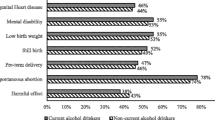Abstract
Introduction The prevalence of ethanol use in many Sub-Saharan African countries is high, but little research exists on use during pregnancy. The objective of this study was to assess the prevalence and predictors of ethanol use among pregnant women in Southwestern Uganda. Methods This descriptive, cross-sectional study was conducted in the maternity ward at Mbarara Regional Referral Hospital (MRRH). All pregnant women giving birth at MRRH between September 23, 2013 and November 23, 2013 were eligible for enrollment. The primary outcome was the proportion of women with ethanol use during pregnancy as determined by self-report. Secondary outcomes included the proportion with positive fatty acid ethyl ester (FAEE) results (indicating ethanol use) and positive TWEAK questionnaire results (indicating possible problem drinking). Predictors of ethanol use were assessed and stratified by patterns of ethanol intake. Results Overall, 505 mother–child dyads enrolled in the study. The proportion of women who reported any ethanol use during pregnancy was 16 % (n = 81, 95 % CI 13–19 %) and the prevalence of heavy drinking 6.3 % (n = 32, 95 % CI 3.8–7.9 %). The strongest predictor of use during pregnancy was pre-pregnancy use, with maternal education as a protective factor. Few neonates (n = 11, 2 %) tested positive for FAEE > 2.00 nmol/g in meconium. The TWEAK questionnaire captured 75 % of women who reported moderate/heavy drinking and aligned more with self-reported ethanol use than meconium results. Conclusions The substantial prevalence and clear predictors of ethanol use suggest that legislative action and educational interventions to increase awareness of potential harms could assist in efforts to decrease use during pregnancy in Southwestern Uganda.


Similar content being viewed by others
References
Allen, J., & Wilson, V. B. (2003). Assessing alcohol. http://pubs.niaaa.nih.gov/publications/AssessingAlcohol/.
Bryanton, J., Gareri, J., Boswall, D., McCarthy, M. J., Fraser, B., Walsh, D., et al. (2014). Incidence of prenatal alcohol exposure in Prince Edward Island: A population-based descriptive study. CMAJ Open, 2(2), E121–E126. doi:10.9778/cmajo.20140011.
Burd, L., & Hofer, R. (2008). Biomarkers for detection of prenatal alcohol exposure: A critical review of fatty acid ethyl esters in meconium. Clinical and Molecular Teratology, 82(7), 487–493.
Chan, D., Bar-Oz, B., Pellerin, B., Paciorek, C., Klein, J., Kapur, B., et al. (2003). Population baseline of meconium fatty acid ethyl esters among infants of nondrinking women in Jerusalem and Toronto. Therapeutic Drug Monitoring, 25(3), 271–278.
Clarren, S. K., Cook, J. L., & Canada FASD Research Network. (2013). Meconium screening for fetal alcohol spectrum disorder in pregnancy. http://www.canfasd.ca/wp-content/uploads/2014/01/Meconium-screening-for-FASD-in-pregnancy-FINAL.pdf.
Culley, C. L., Ramsey, T. D., Mugyenyi, G., Kiwanuka, G. N., Ngonzi, J., MacLeod, S., et al. (2013). Alcohol exposure among pregnant women in sub-Saharan Africa: A systematic review. Journal of Population Therapeutics and Clinical Pharmacology, 20(3), 321–333.
Gareri, J., Lynn, H., Handley, M., Rao, C., & Koren, G. (2008). Prevalence of fetal ethanol exposure in a regional population-based sample by meconium analysis of fatty acid ethyl esters. Therapeutic Drug Monitoring, 30(2), 239–245. doi:10.1097/FTD.0b013e318167cfe5.
Larkby, C., Day, N., & Words, E. Y. (1997). The effects of prenatal alcohol exposure. Alcohol Health and Research World, 21(3), 192–198. doi:10.1007/s11065-011-9168-8.
MacLeod, S., & Koren, G. (2011). Meconium testing for fatty acid ethyl esters: A 2011 status report. Journal of Population Therapeutics and Clinical Pharmacology, 18(3), e500–e502.
Martinez, P., Røislien, J., Naidoo, N., & Clausen, T. (2011). Alcohol abstinence and drinking among African women: Data from the World Health Surveys. BMC Public Health, 11(1), 160. doi:10.1186/1471-2458-11-160.
Namagembe, I., Jackson, L. W., Zullo, M. D., Frank, S. H., Byamugisha, J. K., & Sethi, A. K. (2010). Consumption of alcoholic beverages among pregnant urban Ugandan women. Maternal and Child Health Journal, 14(4), 492–500. doi:10.1007/s10995-009-0500-3.
National Task Force Fetal Alcohol Syndrome and Fetal Alcohol Effect. (2009). Reducing alcohol-exposed pregnancies. http://198.246.124.29/ncbddd/fasd/documents/redalcohpreg-textonly.pdf.
Obot, I. S., & Room, R. (2005). Alcohol, gender, and drinking problems: Perspectives from low and middle income countries. http://www.who.int/entity/substance_abuse/publications/alcohol_gender_drinking_problems.pdf#page=12\npapers3://publication/uuid/010C5AEE-62B6-4CFB-9142-4AD1F5B40E5A.
Rendall-Mkosi, K., London, L., Adnams, C., Morojele, N., McLoughlin, J.-A., & Goldstone, C. (2008). Fetal alcohol spectrum disorder in South Africa: Situational and gap analysis. http://www.unicef.org/southafrica/SAF_resources_fetalalcohol.pdf.
Rosenthal, J., Christianson, A., & Cordera, J. (2005). Fetal alcohol syndrome prevention in South Africa and other low-resource countries. American Journal of Public Health, 95(7), 1099–1101. doi:10.2105/AJPH.2004.057372.
Russell, M. (1994). New assessment tools for risk drinking during pregnancy: T-ACE, TWEAK and others. Alcohol Health and Research World, 18(1), 55–61.
Russell, M., Martier, S. S., & Sokol, R. J. (1996). Detecting risk drinking during pregnancy: A comparison of four screening questionnaires. American Journal of Public Health, 86, 1435–1439.
World Health Organization. (2014). Global status report on alcohol and health 2014. http://www.who.int/substance_abuse/publications/global_alcohol_report/msbgsruprofiles.pdf.
Zelner, I., Kenna, K., Brien, J. F., Bocking, A., Harding, R., Walker, D., et al. (2013). Meconium fatty acid ethyl esters as biomarkers of late gestational ethanol exposure and indicator of ethanol-induced multi-organ injury in fetal sheep. Plos One, 8(3), e59168. doi:10.1371/journal.pone.0059168.
Author information
Authors and Affiliations
Corresponding author
Rights and permissions
About this article
Cite this article
English, L.L., Mugyenyi, G., Nightingale, I. et al. Prevalence of Ethanol Use Among Pregnant Women in Southwestern Uganda. Matern Child Health J 20, 2209–2215 (2016). https://doi.org/10.1007/s10995-016-2025-x
Published:
Issue Date:
DOI: https://doi.org/10.1007/s10995-016-2025-x



